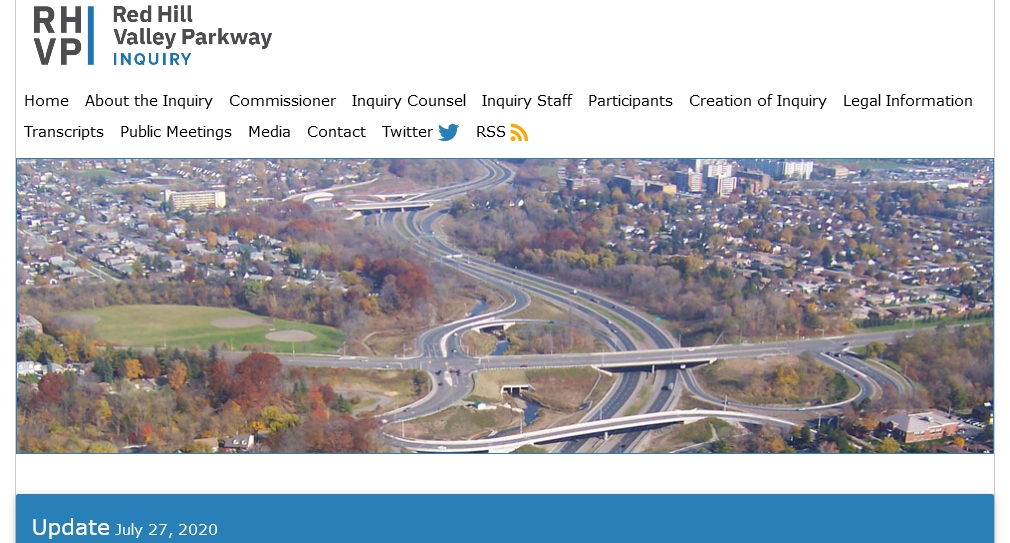“I just can’t recall either way. I don’t. I’m not disputing that it may have taken place, but I don’t recall.”
This is how the City of Hamilton’s retired Director of Engineering Gary Moore responded when repeatedly confronted with the testimony of others stating he told them more lighting on the Red Hill Valley Parkway was prohibited by the original Environmental Assessment.
The Red Hill Valley Parkway Inquiry is exploring the power dynamics at Hamilton City Hall that enabled the burying of a 2013 friction report.
The 2013 Tradewinds report found low friction levels along part of the Red Hill Valley Parkway. Many of these low friction areas coincided with higher than average wet weather collisions.
Moore is at the centre of the scandal.
He had the report.
Thus far, evidence shows he did not share it with any other members of City staff or City Council.
Moore repeatedly stated there were no friction issues on the highway, and at times stated the parkway’s friction exceeded that of other similar roadways.
The Inquiry has also focused on the relationship between Council direction, the City’s senior public works managers, and how managers oversee and pressure consultants to change reports.
During the time period between 2012 to 2018, Hamilton city councillors repeatedly expressed concerns about lighting on the Red Hill Valley Parkway in response to complaints from Hamiltonians who stated they could not see clearly see the parkway’s lanes at night, especially during inclement weather.
Evidence before the Inquiry states Moore told people that the original Environment Assessment for the construction of the RHVP prohibited any additional lighting on the Parkway.
This has been the testimony of numerous City of Hamilton managers and directors, including Gord McGuire and Mike Fields.
CORRECTION: Gord McGuire has not testified yet. In audio entered into evidence, McGuire stated “Gary’s response has always been, has been an Environmental Assessment done in the original Red Hill, that barred lighting 100%,because of the influence on the natural environment. We retained CIMA, we went through every document out there, there is no there is no exclusion for lighting on those facilities.” [http://rhvpi.ca/od/Documents/HAM/HAM0054128_0001.wma at approximately 00:49:32 – 00:52:07]
During the summer of 2018, after Moore retired, other City staff discovered the 2013 friction report that Moore filed in a shared document system days before his May 25, 2018, retirement.
This led to an extensive review of Red Hill documentation as the revelation to staff that the original Environmental Assessment did not prohibit additional lighting.
The Friday afternoon questions at the Inquiry turned to what Moore told people, and why Moore either believed or told people that the original EA prohibited more lighting.
Moore was evasive in responding to questions.
Moore stated people had a different interpretation of his statements or stated he did not recall.
His statement, “I’m not disputing that it may have taken place,” is significant in this context.
Inquiry Commissioner co-lead Counsel Emily Lawrence began her lighting questioning simply.
“In 2013, what constraints, if any, did you understand existed in respect of making changes to illumination on the Red Hill?”
Lawrence had to pose the question three times before Moore responded to the question itself.
“Well, there were physical constraints, but there was also the fact that what had been installed was what had been approved under the EA. [Environmental Assessment],” Moore stated.
Lawrence followed up Moore’s answer by asking him to elaborate on physical constraints.
Moore stated the Ontario Hydro transmission lines, which pass over the highway at the Mud Street interchange, “made it difficult, if not impossible, to implement lighting in that area. They won’t allow poles under their transmission lines.”
He said the bridges along the Red Hill Parkway were another constraint.
“I’m not sure that the bridges were, were built to accommodate to light standards, you know, on the bridges or on the parapet walls or the barrier walls that separated those certain areas. So there’s, there was a lot of physical constraints in that regard.”
Lawrence repeatedly asked Moore specific questions about the Environment Assessment, did it state that the Red Hill could not have more lighting, could not have full illumination?.
Moore repeatedly tried to redirect and rephrase the question.
Lawrence pressed, “My question was specifically that the EA didn’t have anything that had grappled with the issue of full illumination and rejected it. Is that right?”
Moore responded, “There are hundreds of documents in there and letters, so I’m not sure that that’s what level it’s rejected,” before going into a lengthy listing of other things.
Lawrence tried again, “Mr. Moore, if you can focus on my question and answer my question first … if you can really listen to my question … Do you see a distinction and that distinction I’m trying to get at is an EA that approves decision point, lighting, lighting, would be different than an EA that rejects expressly, full illumination.”
Moore replied, “My understanding is that that’s not the way the EA operates.”
“Okay, I’m going to move on,” Lawrence ended the line of questioning.
The remainder of the afternoon continued with questions that Moore responded to with a combination of “I do not recall” and evasive non-answers.
Moore returns to the stand Monday morning.
Production Details v. 1.0.0 Last edited: July 18, 2022 Author: Joey Coleman Edit Record v. 1.0.0 original version v. 2.0.0 CORRECTION: McGuire has not yet testified. Author confused audio evidence with testimony.

